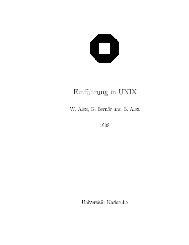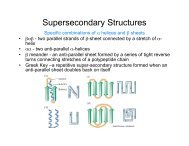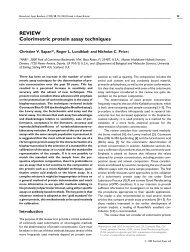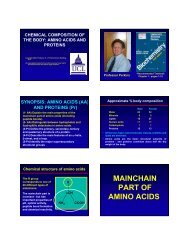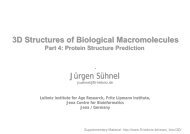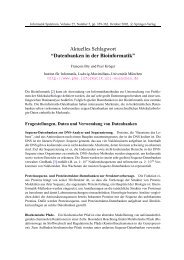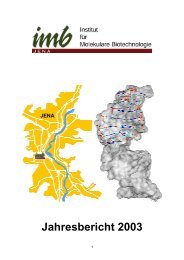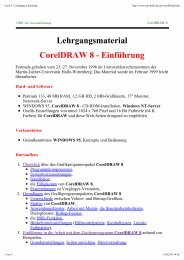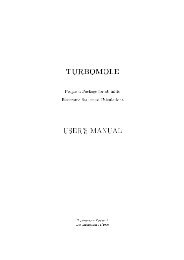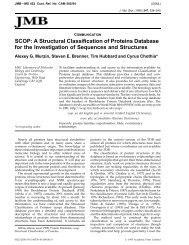Protein Classification and Structure Prediction Amino acid ...
Protein Classification and Structure Prediction Amino acid ...
Protein Classification and Structure Prediction Amino acid ...
Create successful ePaper yourself
Turn your PDF publications into a flip-book with our unique Google optimized e-Paper software.
Experimentation to grow<br />
protein crystals<br />
X-Ray Crystallography<br />
Trial-<strong>and</strong>-error<br />
Experimentation<br />
Observables<br />
Partial Success<br />
~0.5mm<br />
Trial 1<br />
Control<br />
Parameters<br />
Failure<br />
Success<br />
Trial 3<br />
Trial 2<br />
• The crystal is a mosaic of millions of copies<br />
of the protein.<br />
• As much as 70% is solvent (water)!<br />
• May take months (<strong>and</strong> a “green” thumb) to<br />
grow.<br />
Krane & Raymer<br />
Krane & Raymer<br />
X-Ray diffraction<br />
• Image is averaged over:<br />
• Space (many copies)<br />
• Time (of the diffraction experiment)<br />
<strong>Protein</strong> Crystal Growth in Space<br />
• <strong>Protein</strong> crystal growth experiments on over 20 shuttle<br />
missions since 1984<br />
• Larger Crystals in 45.4% of the cases<br />
• New Crystal <strong>Structure</strong>s in 18% of the cases<br />
• ≥ 10% increase in X-Ray X<br />
Crystallography Brightness in 58%<br />
of the cases<br />
• Less thermal motion in 27.2% of the cases<br />
• An X-Ray X<br />
Crystallography resolution improvement of ~0.3 Å<br />
in 42.4% of the cases<br />
• An X-Ray X<br />
Crystallography resolution improvement of 0.3 to<br />
0.5 Å in 9.9% of the cases<br />
• An X-Ray X<br />
Crystallography resolution improvement of 0.5 to<br />
1.0 Å in 9.9% of the cases<br />
Krane & Raymer<br />
The <strong>Protein</strong> Folding Problem<br />
• <strong>Protein</strong>s self-assemble in solution. Almost all of the<br />
information necessary to determine the complex 3-D 3<br />
structure is in the amino <strong>acid</strong> sequences<br />
• Central dogma:<br />
Sequence specifies structure<br />
• Central question:<br />
“Given a particular sequence of<br />
amino <strong>acid</strong> residues (primary structure), what will the<br />
tertiary/quaternary structure of the resulting protein be?”<br />
Levinthal’s paradox<br />
• Consider a 100 residue protein. If each residue<br />
can take only 3 positions, there are 3 100 = 5 ×<br />
10 47 possible conformations.<br />
• If it takes 10 -13<br />
s to convert from 1 structure to<br />
another, exhaustive search would take 1.6 × 10 27<br />
years!<br />
5



